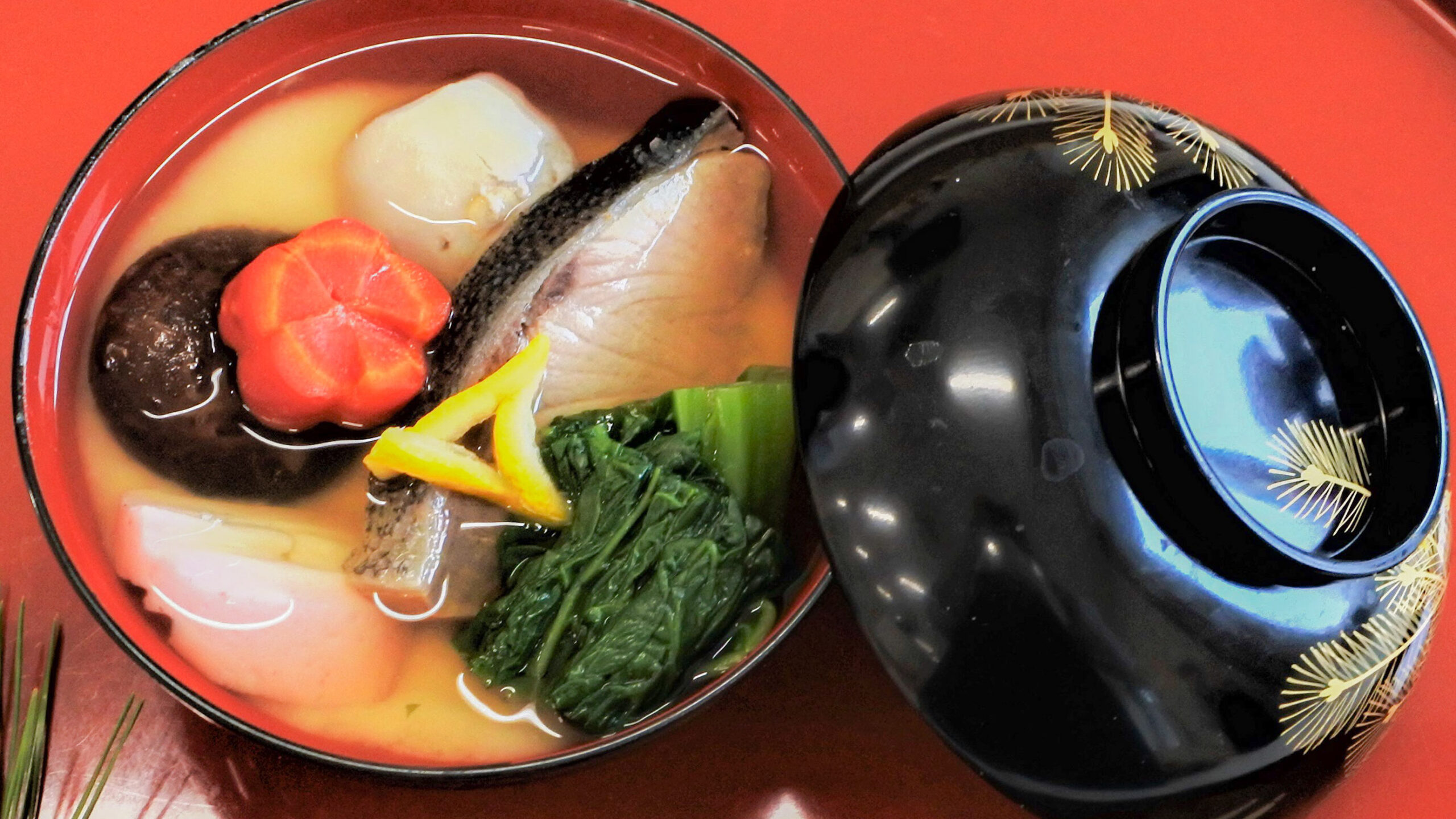
Hey there! Ever heard of ‘Hakata Zoni’? It’s a special kind of New Year’s mochi soup from Fukuoka Prefecture, specifically the Hakata area, and it’s got a personality all its own. What makes it stand out? Well, for starters, it’s packed with goodies like buri (adult yellowtail), shiitake mushrooms, taro, carrots, daikon radish, and a local leafy green called katsuona. Plus, the way it’s put together is pretty neat – almost like a Japanese oden with all the ingredients prepped on skewers. It’s a delicious and fascinating glimpse into Hakata’s history and hospitality!
Dish Name: Hakata Zoni
- Region / Location: Fukuoka Prefecture
- Primary Area of Tradition: Hakata area
- Main Ingredients: Small round mochi (rice cakes), buri (adult yellowtail), shiitake mushrooms, taro, carrots, katsuona (a type of leafy green), daikon radish.
How It’s Eaten / Served
Hakata Zoni is made with a broth based on grilled ago (flying fish) and includes buri. The mochi are round, and it’s loaded with various ingredients such as katsuona, kamaboko (fish cake), taro, carrots, daikon radish, and shiitake mushrooms. While the exact ingredients can vary slightly from family to family, katsuona is a must-have. The mochi and other ingredients are cooked separately in different pots. To serve, they are added to bowls of pre-heated broth. A unique characteristic of Hakata Zoni is that the ingredients are often prepared by skewering them individually on bamboo sticks beforehand. This allowed busy Hakata merchant wives (“goryonsan”) to quickly serve the many guests who would visit during the New Year.
Cultural Background and Preservation
Katsuona, a leafy vegetable similar to mustard greens with a flavor reminiscent of bonito flakes (katsuo-bushi), is an essential ingredient in Hakata Zoni and has been around in Hakata for a long time. Buri, a fish that changes its name as it grows (a “promotion fish”), is often used for celebratory occasions. One theory about why buri is in Hakata Zoni is tied to a custom where a groom’s family would present a large buri to the bride’s family at the end of the year, symbolizing a “good catch” of a bride. This likely led to its use in New Year’s osechi (traditional New Year’s food) and zoni. The unique preparation style of skewering the ingredients came about because Hakata was historically a town of merchants, and their wives, the “goryonsan,” were often busy entertaining many guests. Prepping the ingredients on skewers allowed for quick assembly and serving of the zoni during the busy New Year period. Hakata Zoni is still enjoyed in the Hakata area today. Its rich flavor and generous ingredients have made it popular throughout Japan, and it’s even available through online sales and as a special offering in restaurants.
Additional information:
- Mochi: Japanese rice cakes made from glutinous rice. They have a chewy and slightly sticky texture and are a traditional food for the New Year in Japan.
- Buri (Adult Yellowtail): A type of fish that is considered auspicious in Japan due to its changing names as it grows, symbolizing advancement and good fortune.
- Katsuona: A local leafy green vegetable from the Hakata area, related to mustard greens, with a flavor that has a hint of bonito flakes.
- Ago (Flying Fish): A type of fish often dried and grilled to make a flavorful broth, especially popular in the Kyushu region of Japan.
- Osechi: Traditional Japanese New Year’s food, consisting of a variety of dishes packed in special boxes (jubako), each with symbolic meaning for the new year.
The information about regional cuisine featured on this website (Piggy's Grandma of Japan) is summarized and adapted from the Ministry of Agriculture, Forestry and Fisheries of Japan (MAFF) website, "Our Regional Cuisines"Additional commentary is provided based on the unique experiences and perspectives of the site's editors.
The copyright for the original content regarding regional cuisine belongs to the Ministry of Agriculture, Forestry and Fisheries of Japan.
The summaries and adaptations published on this site are intended for informational purposes only. Piggy's Grandma of Japan does not guarantee the accuracy or completeness of this information. For the most accurate and complete details, please refer to the original pages on the MAFF website.

